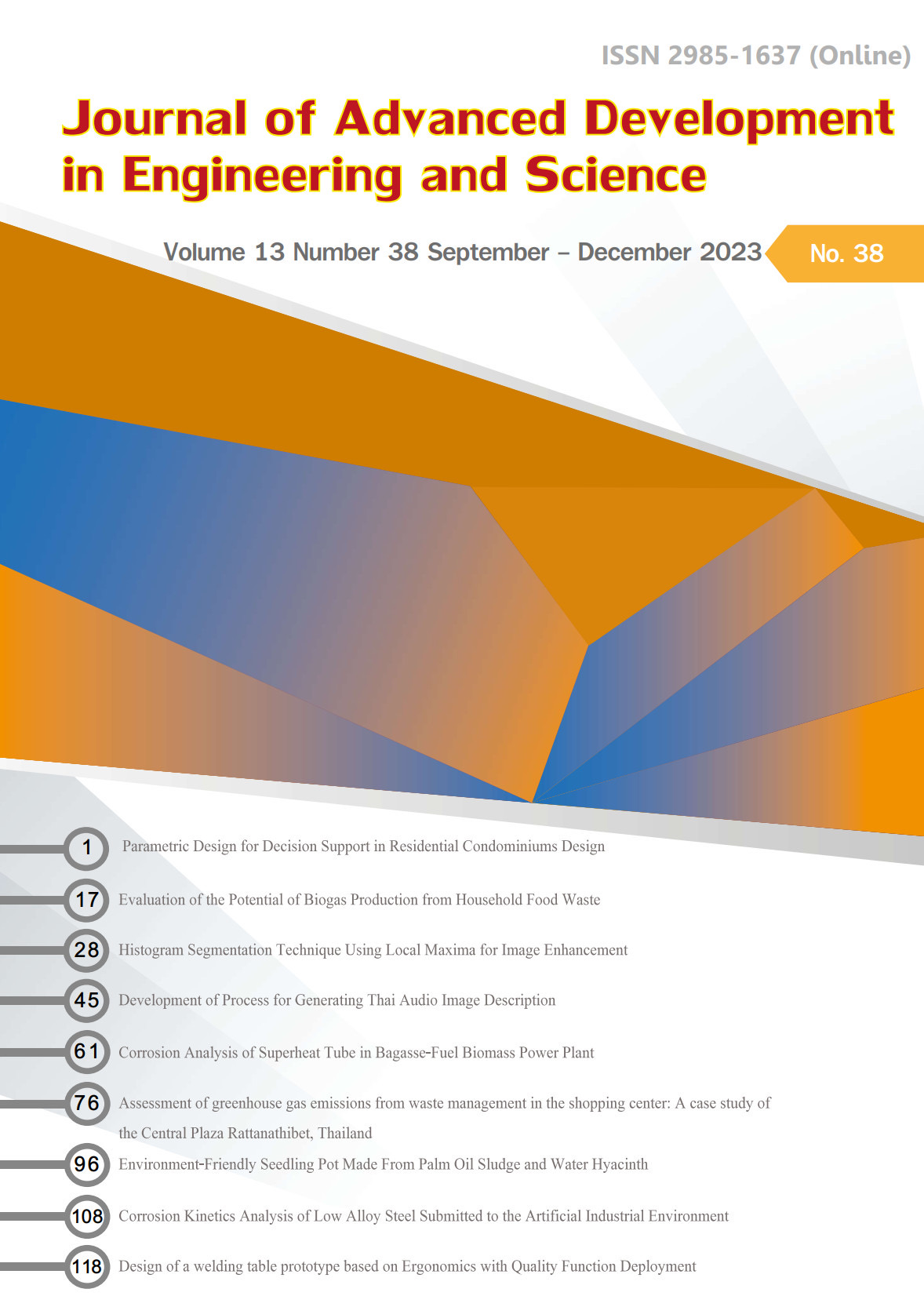การวิเคราะห์การกัดกร่อนของท่อไอดงในโรงไฟฟ้าชีวมวลที่ใช้ชานอ้อยเป็นเชื้อเพลิง
Main Article Content
บทคัดย่อ
งานวิจัยนี้เป็นการวิเคราะห์การกัดกร่อนของท่อไอดงในโรงไฟฟ้าชีวมวลที่ใช้ชานอ้อยเป็นเชื้อเพลิง โดยวัสดุที่ใช้ศึกษาเป็นเหล็กกล้าคาร์บอนต่ำเกรด STBA12 ผลการทดลองพบว่าในฟาวลิ่งที่สะสมอยู่บนผิวท่อประกอบด้วยโพแทสเซียมซัลเฟต (K2SO4) โพแทสเซียมคลอไรด์ (KCl) และสารประกอบยูเทคติกที่มีจุดหลอมเหลวต่ำเช่น KCl-K2SO4 เมื่อท่อมีการใช้งานในช่วงอุณหภูมิ 510-780 องศาเซลเซียส สสารประกอบเกลือยูเทคติกเกิดการหลอมเหลว ซึ่งเกลือเหลวนี้เป็นสารตั้งต้นที่สามารถกัดกร่อนท่อไอดงที่ทำมาจากเหล็กได้ จากการตรวจสอบภาคตัดขวางพบการกัดกร่อนที่เกิดจากการออกซิเดชันที่อุณหภูมิสูง (ชั้นออกไซด์) ที่ทำ ให้โลหะบางลงแบบสม่ำเสมอซึ่งเป็นการกัดกร่อนทั่วไปที่พบเมื่อมีการใช้งานโลหะที่อุณหภูมิสูง นอกจากนี้ยังพบการกัดกร่อนแบบเฉพาะที่ ได้แก่ การกัดกร่อนจากกำมะถัน (S-attack) และการกัดกร่อนจากคลอรีน (Cl-attack) ที่เกิดจากเกลือเหลวและผลิตภัณฑ์ของปฏิกิริยาซัลเฟชัน โดยการกัดกร่อนจากกำมะถันมีลักษณะเป็นปลายแหลมเข้าไปในโลหะตามขอบเกรนลึกประมาณ 5-10 ไมครอน ในขณะที่การกัดกร่อนจากคลอรีนมีเกิดตามขอบเกรนเช่นกัน แต่มีความลึกประมาณ 20-50 ไมครอน โดยแหล่งของคลอรีนมาจากเกลือเหลวและผลิตภัณฑ์ที่มาจากปฏิกิริยาซัลเฟชันได้แก่ ก๊าซคลอรีน(Cl2) และไฮโดรเจนคลอไรด์ (HCl)
Article Details

อนุญาตภายใต้เงื่อนไข Creative Commons Attribution-NonCommercial-NoDerivatives 4.0 International License.
เนื้อหาและข้อมูลในบทความที่ลงตีพิมพ์ใน Journal of Advanced Development in Engineering and Science ถือเป็นข้อคิดเห็นและความรับผิดชอบของผู้เขียนบทความโดยตรง ซึ่งกองบรรณาธิการวารสารไม่จำเป็นต้องเห็นด้วยหรือร่วมรับผิดชอบใดๆ
บทความ ข้อมูล เนื้อหา ฯลฯ ที่ได้รับการตีพิมพ์ในJournal of Advanced Development in Engineering and Science ถือเป็นลิขสิทธิ์ของ Journal of Advanced Development in Engineering and Science หากบุคคลหรือหน่วยงานใดต้องการนำทั้งหมดหรือส่วนหนึ่งส่วนใดไปเผยแพร่ต่อหรือเพื่อกระทำการใดๆ จะต้องได้รับอนุญาตเป็นลายลักษณ์อักษรจาก Journal of Advanced Development in Engineering and Scienceก่อนเท่านั้น
เอกสารอ้างอิง
Niu, Y., et al. (2016). Ash-related issues during biomass combustion: Alkali-induced slagging, silicate melt-induced slagging (ash fusion), agglomeration, corrosion, ash utilization, and related countermeasures. Progress in Energy and Combustion Science, 52, 1-61.
Hupa, M., et al. (2017). Biomass combustion technology development – It is all about chemical details. Proceedings of the Combustion Institute, 36(1), 113-134.
Jagustyn, B., et al. (2017). The content and emission factors of heavy metals in biomass used for energy purposes in the context of the requirements of international standards. Journal of the Energy Institute, 90(5), 704-714.
Blomberg, T. (2006). Which are the right test conditions for the simulation of high temperature alkali corrosion in biomass combustion?. Materials and Corrosion, 57(2), 170-175.
Nielsen, H. P., et al. (2000). The implications of chlorine-associated corrosion on the operation of biomass-fired Boilers. Progress in Energy and Combustion Science, 26(3), 283-298.
Mori, S., et al. (2022). Fireside and steamside performance in biomass power plant. Materials at High Temperatures. 39(2), 106-121.
Pettersson, J., et al. (2011). The Effects of KCl, K2SO4 and K2CO3 on the High Temperature Corrosion of a 304-Type Austenitic Stainless Steel. Oxidation of Metals, 76, 93-109.
Li, Y. S. & Spiegel, M. (2004). Internal Oxidation of Fe–Al Alloys in a KCl-Air Atmosphere at 650°C. Oxidation of Metals, 61, 303-322.
Mlonka-Mędrala, A., et al. (2020). Alkali metals association in biomass and their impact on ash melting behaviour. Fuel, 261, 116421.
Janz, G.J., et al. (1979). Physical properties data compilations relevant to energy storage. II. Molten salts: data on single and multi-component salt systems (Research reports). Washington, D.C: National Bureau of Standards.
Blomberg, T., et al. (2004). Role of alkali hydroxides in the fireside corrosion of heat transfer surfaces, a Practical Approach. Materials Science Forum, 461-464, 883-890.
Arvelakis, S., et al. (2004). Simultaneous thermal analysis (STA) on ash from high-alkali biomass. Energy & Fuels, 18(4), 1066-1076.
Hu, Z., et al. (2014). Segmented kinetic investigation on condensed KCl sulfation in SO2/O2/ H2O at 523-1023 K. Energy & Fuels, 28(12), 7560-7568
Montgomery, M., et al. (2008). Potential high temperature corrosion problems due to co-firing of biomass and fossil fuels. Materials and Corrosion, 59(10), 783-793.

